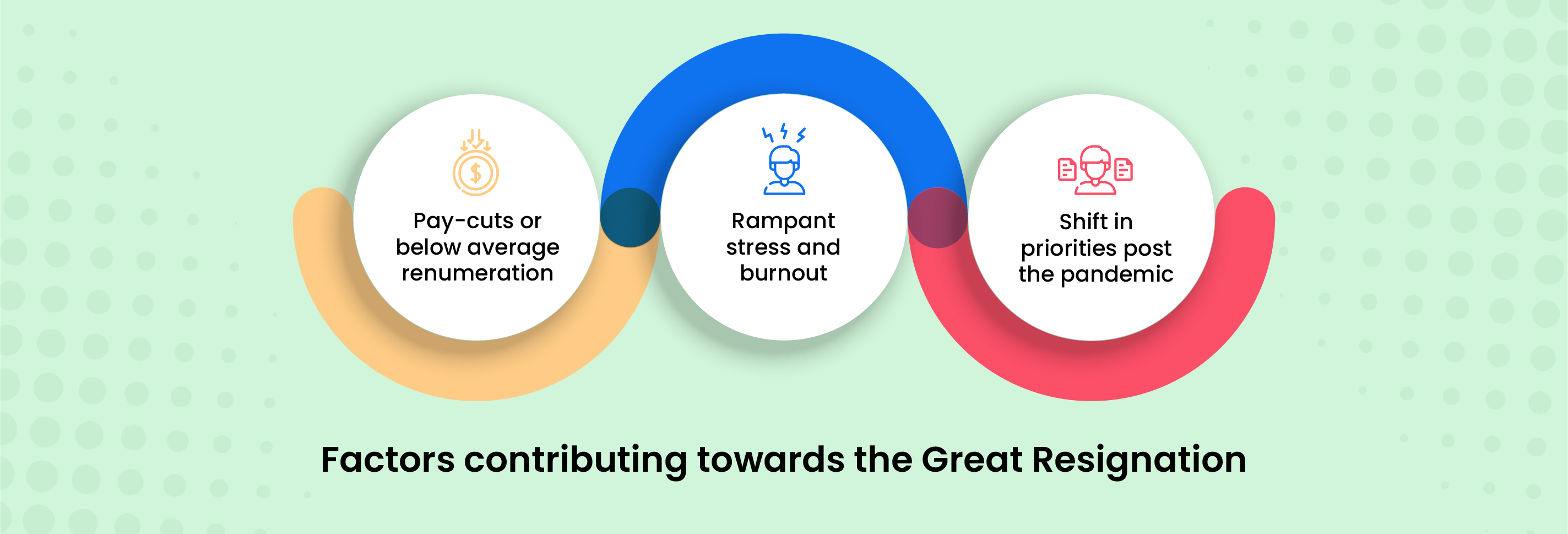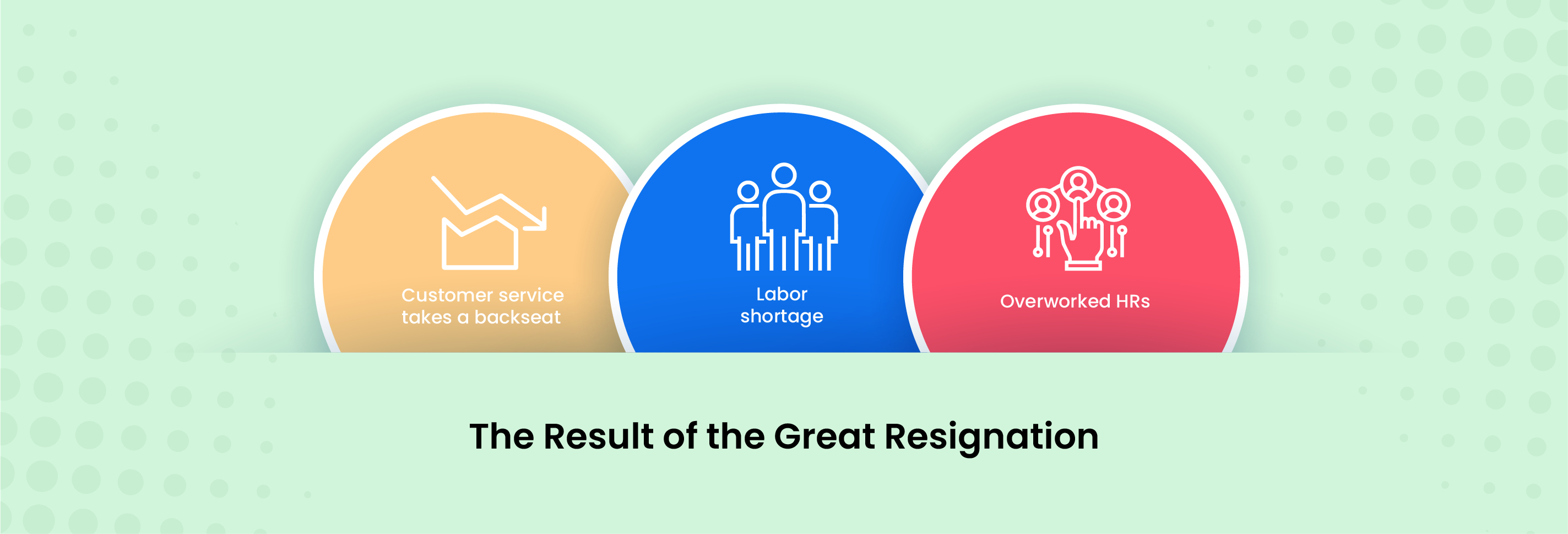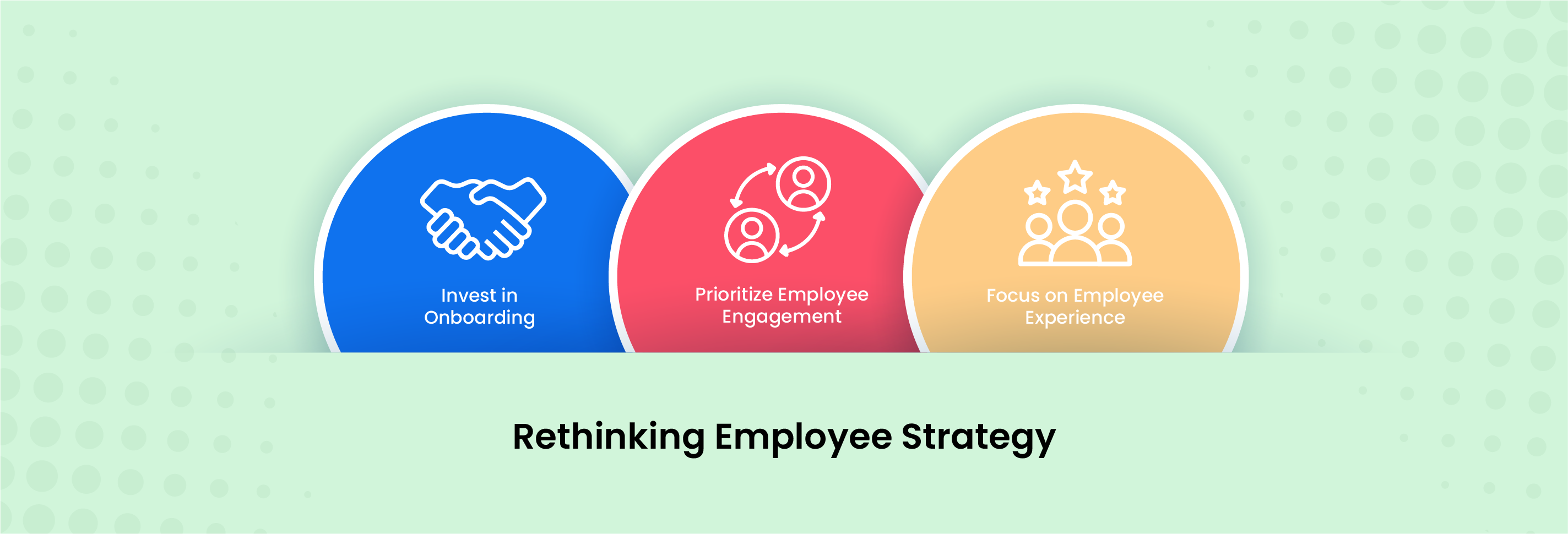The economic and social shock caused by the worldwide outbreak has reshaped the perceptions of individuals and organizations about jobs and occupations. This has resulted in micro and macro shifts in the life of employers and employees. This led to the rise of the great resignation 2021, and in this article, we’re talking all about it.
A recent survey found that close to 54% of employees would seriously consider leaving their jobs if they were not offered some form of flexibility in where and when they work.
The impact of the global outbreak- A shift in focus towards employee well-being

This pandemic has resulted in the largest economic crisis of our generation.
While the crisis itself might end soon, its impact on workplaces around the world may take years to recover. Re-achieving the pre-pandemic levels of stability still appears to be a long way off.
Most workers have started to look for jobs that are more meaningful and that have strong support networks. A lot of people have begun re-evaluating their life’s purpose and many have decided to simply walk away from their previous jobs.
Workers are now leaving jobs in search of more money and flexibility. But more importantly – happiness.
In the United States, resignations soared increasingly high in 2021. To put this into perspective, according to the U.S. Bureau of Labor Statistics, 4 million Americans quit their jobs in July 2021.
All in all, it led to people either feeling dissatisfied, disengaged, ill-equipped, overwhelmed, or just not cared for, resulting in the “Great Resignation” or the “Big Quit”.
Stephen Curry, Chief Executive Officer
What did the pandemic unveil?
The real concern that came to light during the pandemic was how to keep employees engaged to the business and its goals. With multiple lay-offs happening and employee burnout, HRs found it even more difficult to keep employees aligned to their job role. Businesses who did not value employee engagement had to face attrition at significant levels. The shift in the workplace paradigm from office to home made it difficult for employees to perform in the same way. Some of the common changes that became essential for all businesses included:
- The need for transparency and clarity of employee goals for a better alignment between employees and organization.
- The need to adopt updated methods of employee engagement that are backed by employee feedback data.
- The need to build leaders in the organization who would encourage a healthy work environment and inspire the workforce.
- The need to put employee wellbeing first to build a self-motivated workforce that believes in the values of the organization.
Factors contributing towards the Great Resignation

Compensation
The pandemic forced most employers to cut their employees’ pay. This meant reduced overall income for most people.
Employees expected a greater incentive from their employers during the difficult times.
But here’s what income and poverty in the United States looked like in 2020 –
- Median household income decreased 2.9%, to $67,521 – the first such drastic decline since 2011
- The number of full-time job-holders declined by 13.7 million
- 37.2 million people were pushed to poverty – 3.3 million more than in 2019
- Between 2019 and 2020, poverty rates increased for married-couple families and families with a female householder
Remote-working
Work, for most people, means more than just a paycheck — it grows to become a major part of their identity.
A lot of research suggests that when an individual loses their job, the loss of routine, identity and social ties have more negative effects on the well-being of the person than that from the loss of a stable income. As social beings, building meaningful relationships with co-workers and experiencing other social interactions which opens one’s thinking are major contributing factors to employee job satisfaction.
The sudden shift to a remote workspace spoiled the social and intellectual capital of most organizations around the globe. Remote working during the pandemic meant poor communication and even poorer connection to/from managers and colleagues. This took a toll on most employees.
Mental well-being
The global outbreak led to most people facing extreme burnout. This has adversely affected the mental health of many. And so, more employees are talking about mental health at work than ever before.
A study conducted by the Harvard Business Review found that around 76% of people have reported at least one symptom of a mental health condition last year. Of this, 84% of respondents have addressed at least one workplace factor that has negatively impacted their mental health.
In 2020, mental health support at workplaces became an absolute necessity. Now, more people are choosing to quit their jobs primarily for mental health reasons.
In fact, 81% of Gen Zers and 68% of Millennials have resigned from their jobs for mental health reasons from 2020-21. The most common factor for the same was how emotionally draining work had become since the pandemic. Employees found their work stressful, monotonous, overwhelming, and/or boring.
Although some companies have been taking measures to help employees with their mental health, the latter have also increased their expectations regarding the same. However, only 49% of employees say their experience of talking about mental health at work received a positive or supportive response.
“All that has passed over the last two years encouraged and will continue to encourage employees to rethink where and how they work. People are now searching for more meaningful ways of making money beyond the ingrained mentality of the 9 to 5. Taking a less stressful job and supplementing it with gig work enables those once burned-out employees to now find more authentic fulfillment in their lives.”
Tired/unhappy with their managers
Managers play a huge role in an employee’s life cycle at an organization. Their relationship with their seniors is a major contributing factor to help them develop an interest in their work and ultimately perform better.
A team leader stands out as a role model to the team. Additionally, it is a given that managers should be easily accessible to their employees. They also help maintain a healthy work environment and communication channels within the team.
This pandemic, however, disrupted this relationship and affected teams and individuals.
The result of the Great Resignation

Customer service level takes a dip
If there’s one clear message the pandemic has taught most businesses, it has to be that empathy is crucial – empathy towards employees and customers both. And caring for your employees and consumers is only going to help increase your growth rate.
However, it often takes just one poor customer experience to lose that customer for good.
Now, because most people left, organizations were left stranded tackling support with a limited number of resources. Added to that, organizations needed to adapt quickly and work harder to combat the challenges their customers were facing.
Shortage of labor
There are not enough people to do the job across different teams. In fact, job openings in the United States hit a record 10.9 million in July of 2021! However, companies are facing a hard time finding enough and resourceful workers to fill the gaps.
Shortage of labor is obviously going to slow down all processes and projects within the company.
Not enough HR time
To source, screen, onboard, and induct people, HR had to invest a lot more time and resources than they did pre-pandemic.
The increased gap in doing so results in wrong hires and again a high attrition rate of employees or simply disengaged employees who just don’t give their best.
Dragos Badea, CEO
How to turn the Great Resignation into the Great Attraction

Employers should pin and navigate the effects of this pandemic and re-evaluate how to retain the old and recruit new talent. Research by Mckinsey & Company suggests that executives aren’t listening to their people nearly enough.
Companies need to empower their work cultures to take actions that put people first and take steps towards culture change – now more than ever. Here are some aspects employers need to focus on in 2022:
Ask the right questions
Even before you start planning to revamp your engagement or onboarding strategies, you must ask the question that hit right in the nail. It is important for you to understand the which area needs mending, below is the list of questions that you must consider comprehending before building an engagement strategy:
- Do we shelter toxic leaders who don’t make people feel valued?
- Do we have the right people working for the right job roles?
- How much engaged to work and office our employees were before the pandemic?
- Do our employees valued and recognised by the company?
- Are we providing enough personal development and career opportunities to our employees?
- Is there a sense of community among our workforce?
Shannon Bernadin, CEO
Prioritize employee engagement
Organizations need to measure metrics like mental well-being, manager feedback, and compensation satisfaction, among many others. This gives them an upper hand in always knowing the pulse of their employees and taking actions instantly when they see engagement scores going down.
It is crucial to keep the connection and dedication that employees feel towards the organization ignited at all times. Most employees expect their workplaces to promote empathy more than ever now.
Gather regular feedback from your employees across the lifecycle and get intelligent actionable insights. Know about the problem areas, unhappy employees, and engagement trends to build a highly-engaged workforce.
You can conduct timely employee engagement surveys to build a culture of connection.
These conversational employee surveys let you discover real-time actionable insights and know the exact areas where you need to focus your efforts to increase employee engagement.
Also read: The Top 10 Employee Engagement Best Practices 2022 – Revealed
Invest in employee onboarding
Onboarding is an integral process for companies across the globe. This is the process by which a new employee is initiated into the organization.
Employers need to take more time to onboard employees, align them with the company vision and mission, assign them a mentor/buddy, and lay down a short and long-term plan. It is important to invest time and energy in an efficient employee onboarding program.
An Academy of Management Journal Study states that a new hire’s first 90 days are the most crucial in any company. You need to be able to retain talent in your company. Only then, will your company be able to progress and succeed.
Need more statistics to help you understand why employee onboarding will remain a top priority and concern in 2022? Read this report to know!
Also read: Employee Onboarding – How Disruption Has Transformed It And What Lies Ahead
Focus on employee experience
As employers, you cannot forget the employees who chose to stick around and stay back.
Employee experience is the level of satisfaction an employee experiences throughout their journey – from recruitment to exit- in an organization. It’s all about what exactly are you, as an organization, doing to develop a wholesome work culture for your employees.
This also helps you build a deeper connection with your employees. It also lets you ensure that everyone in the company is working towards the company’s vision and mission.
Also read: Employee Engagement vs. Employee Experience – Here’s How the Two Differ
How can Leena AI help?
To ensure all the above-mentioned points are in place in your organization, the HRs and leaders need to go above and beyond to understand what enables or blocks their employees, and why it does so.
To combat this ongoing crisis, employers need to shift towards a more data-driven method of functioning to improve retention rates. This is because, without effective data infrastructure, your organization’s ability to make any strategic decisions will be adversely affected.
This cyclic task requires employers to do so in a consistent and systematic manner. To achieve this, you will have to invest in an intelligent and user-friendly system for tracking and analyzing the data that will help maximize all your efforts.
This is where automation and leveraging the power of AI come in.
Leena AI can become your secret to a high-performing workforce. We can help you quantify the problem, identify the root causes and develop customized retention programs. Our mission is to help enterprises build employee experience that puts people first.
Our system enables HRs to automate most of their processes – from onboarding to engagement and so much more. It combines the ‘human touch’ and automation to make the whole process more efficient and likable.
Build a world-class working culture with us.
Partner with us today and we’ll help you turn the Great Resignation into the Great Retention in 2022 in your organization! Book a demo today.
Frequently Asked Questions (FAQs)
1. What is the Great Resignation of 2021?
Proposed by Professor Anthony Klotz of Texas A&M University, The Great Resignation is a concept that predicts a large number of people quitting their jobs after the global crisis ends. As of today, The Great Resignation is prominent in the United States and is slowly making its way through to the other nations. From reasons related to physical and mental health caused by the pandemic, to shift in priorities for both the employers and employees, there are a number of reasons being stated for mass resignations across industries. It indicates instability in organizational teams and jobs at all levels.
2. How long will the Great Resignation last?
Experts claim the Great Resignation may not last for a long time. It began as a move to help people focus on themselves, and get organizations to pay attention to aspects like mental health, personal and professional growth of employees. Considering how most organizations are rapidly adopting new measures, processes and policies in place to address the concerns and causes driving the Great Resignation, and the introduction of hybrid working, the move is said to be slowly scaling down in some nations. Although, there is no set duration of how long it’d take for the talent market to settle in and understand the new changes organizations are bringing in. This may differ from nation to nation, industry to industry or even on organizational levels.
3. How do you retain employees during the Great Resignation?
To combat this ongoing crisis, employers need to shift towards a work culture that prioritizes employee experience and puts people first. Companies need to adopt a more data-driven method of functioning to continually learn about their employees, their experiences, and their changing expectations. Automation and leveraging the power of AI can play a significant role in helping organizations boost employee engagement by delivering an experience they truly seek in these changing times, helping retain employees during the Great Resignation. We’re seeing a massive shift in employee onboarding best practices, employee day to day engagement efforts and how surveys/ feedback are finding their way back into the HR processes across the employee’s lifecycle.
4. How to attract and retain talent in 2022?
The only way to attract talent in the post-pandemic world going through The Great Resignation, is to put the focus on showcasing the culture of your organization. This includes becoming more vocal about your employee friendly policies, hybrid/ remote work culture, processes you have in place to ensure safety during the post-pandemic times, and how you’re focusing more on aspects like physical and mental health as you resume work across offices. It’s also a good idea to become more transparent about expectations and address queries that talent may have before, during and after the hiring process. It’s better to understand both sides of the story to be able to offer them a more personalized experience with your organization.
5. Why is the Great Resignation happening?
The sudden economic and social shock that the global pandemic presented us with, led to people either feeling dissatisfied, disengaged, ill-equipped, overwhelmed, or just not cared for by the organizations or employers they were working with, resulting in the Great Resignation. While some moved away for monetary reasons, other resignations happened due to the shift in focus to physical and mental health, familial issues or a change in priorities. It is important to note that the reasons for resignation for most employees are different, and organizations should also have a process in place to gather feedback from these leaving employees by conducting an exit interview/ feedback session.







1 Comment